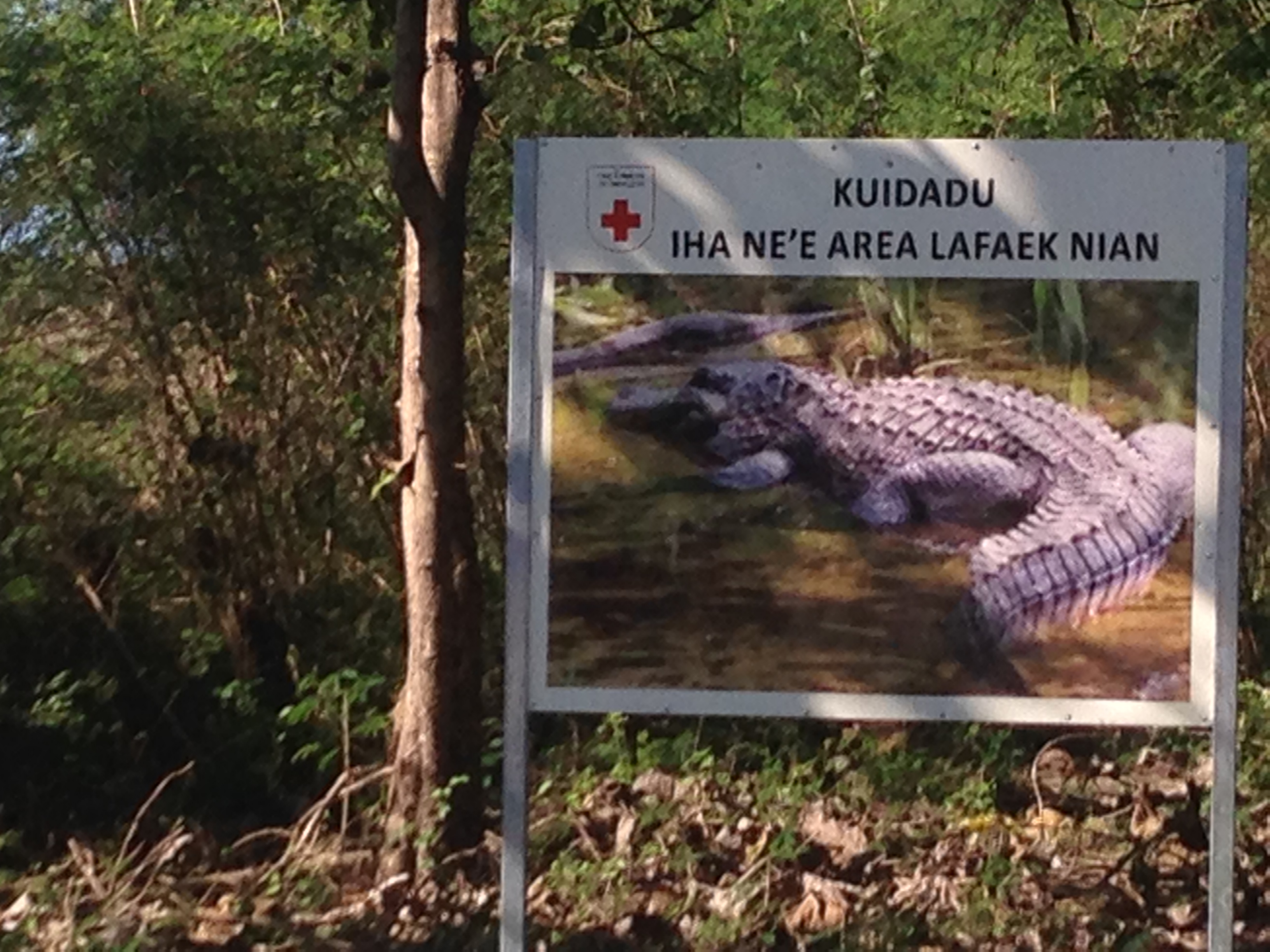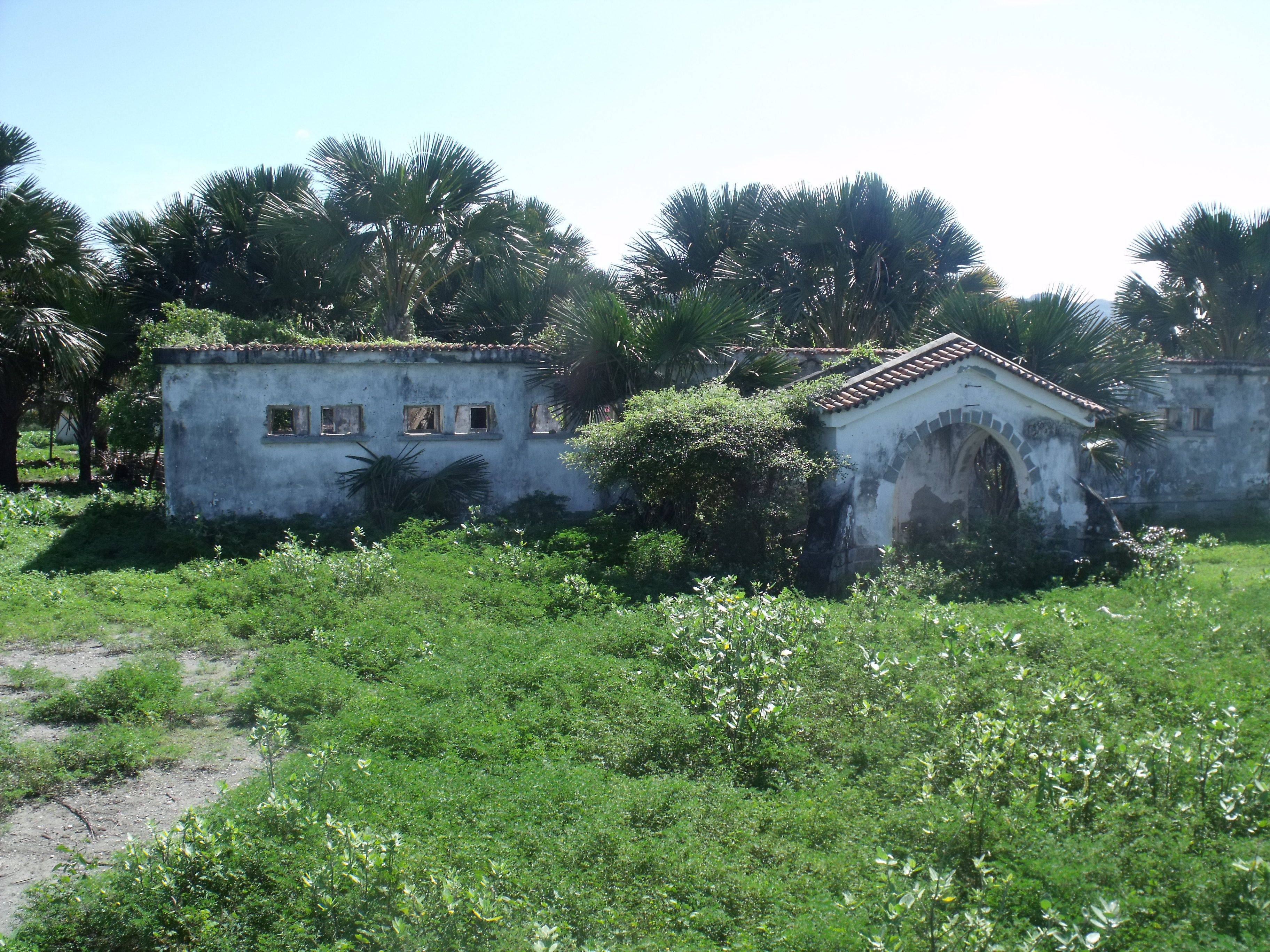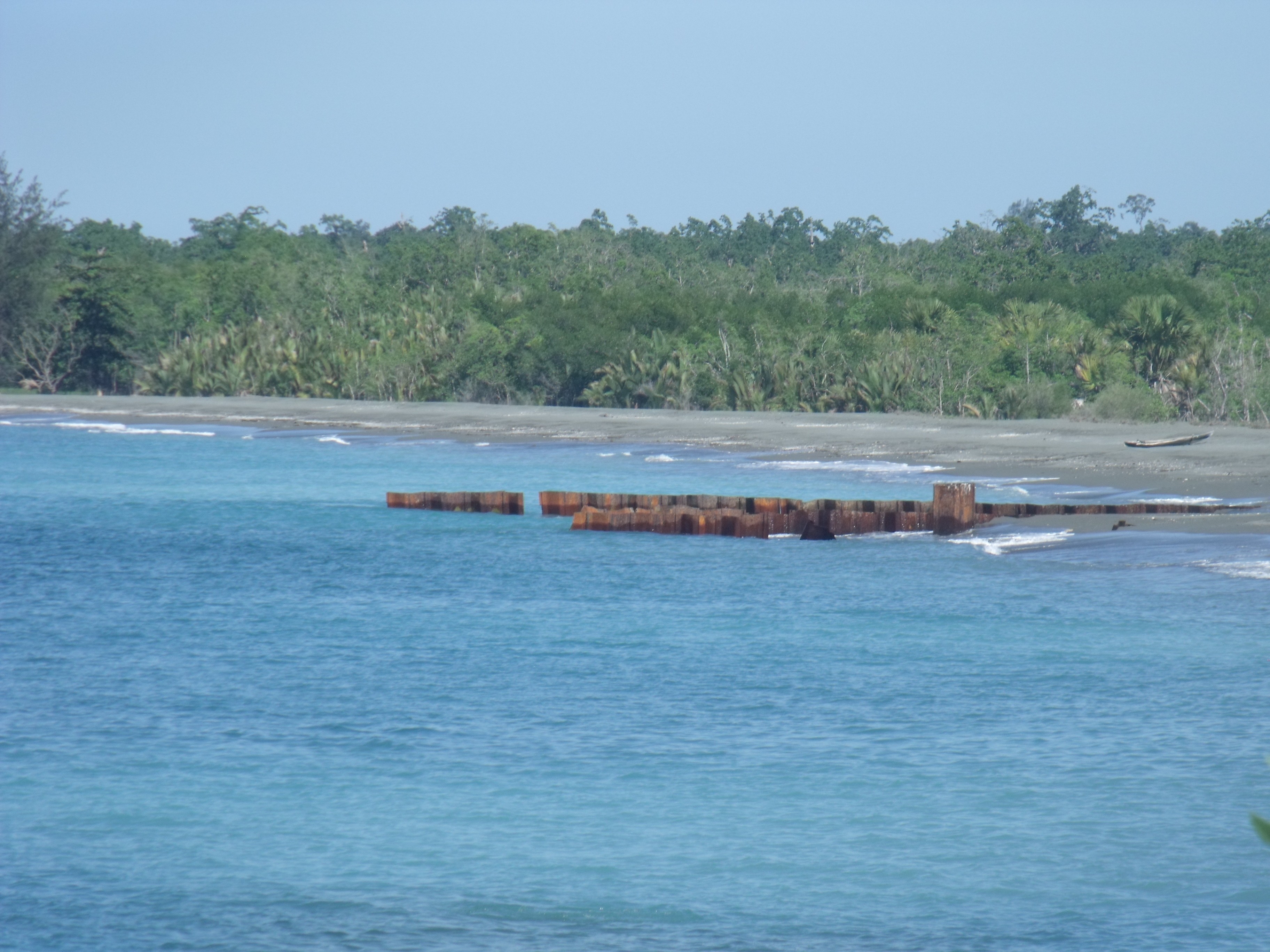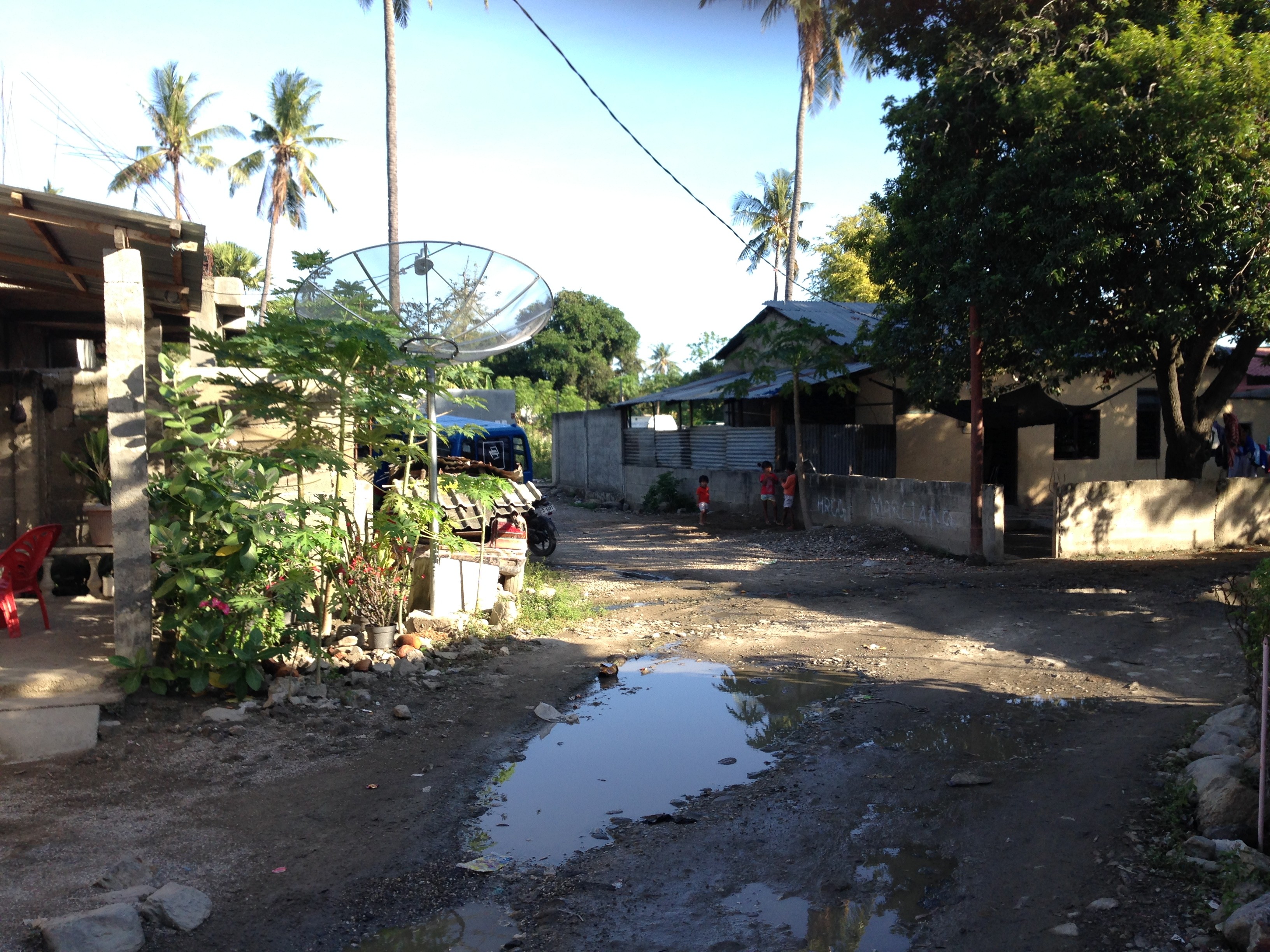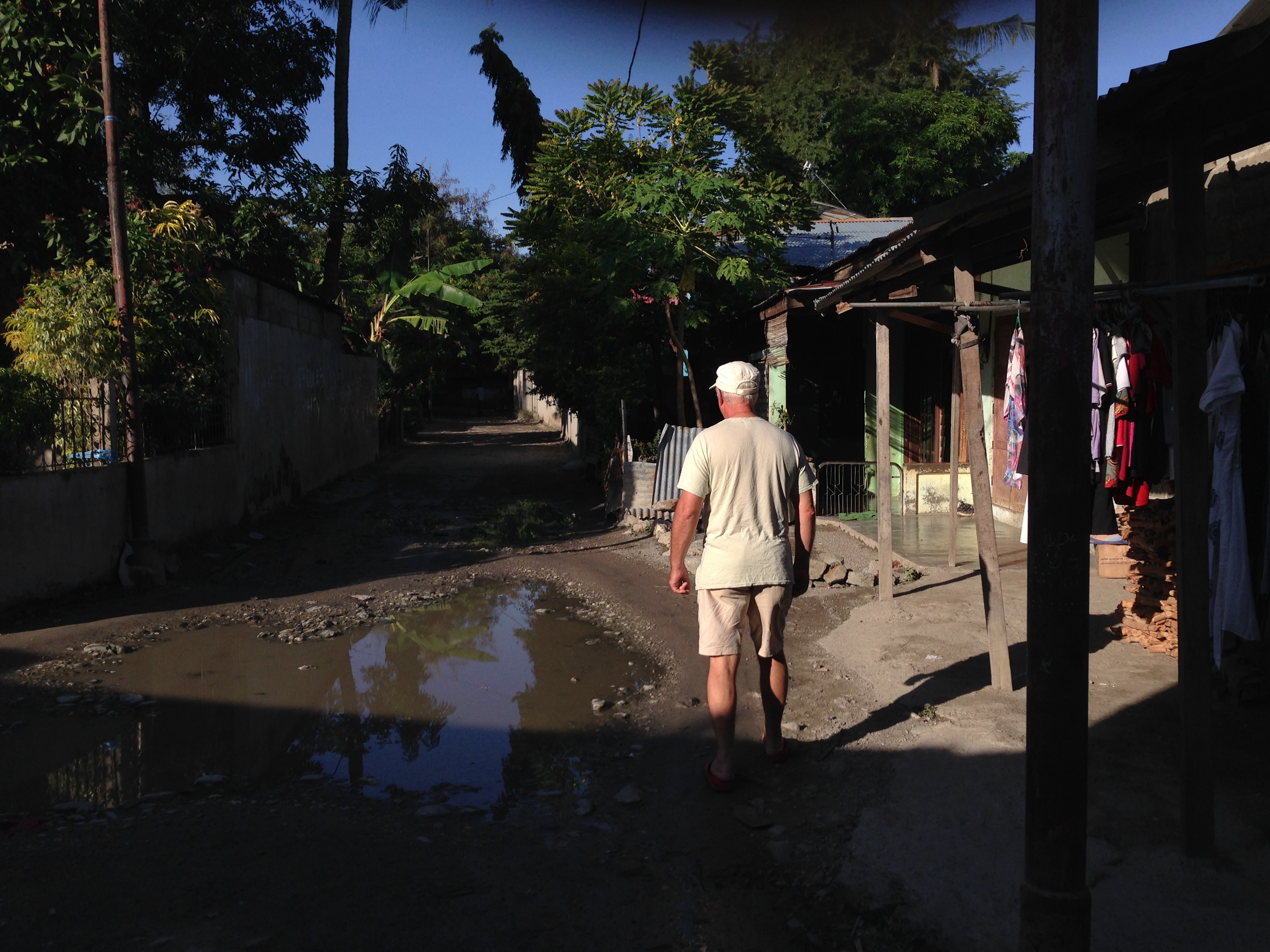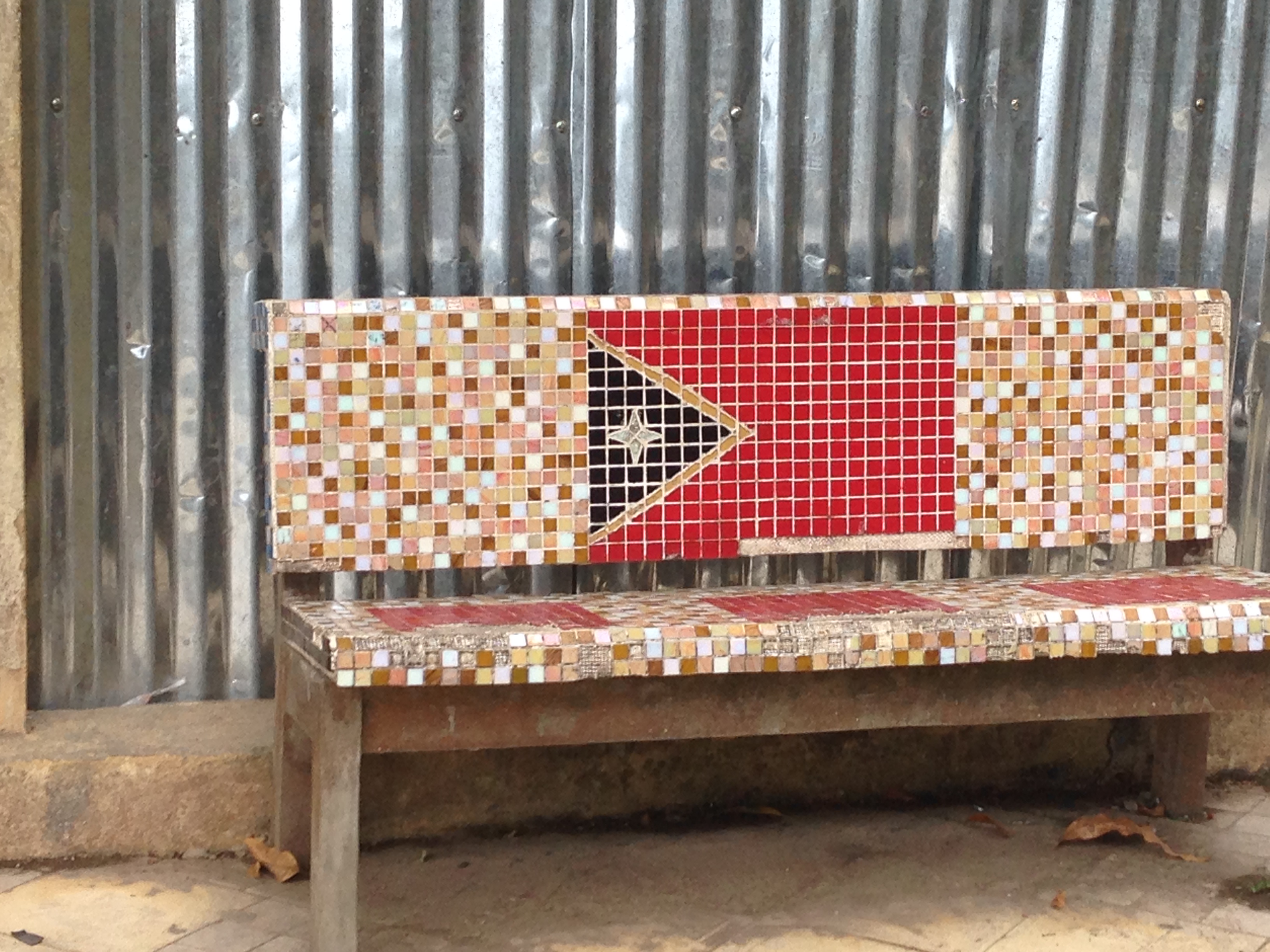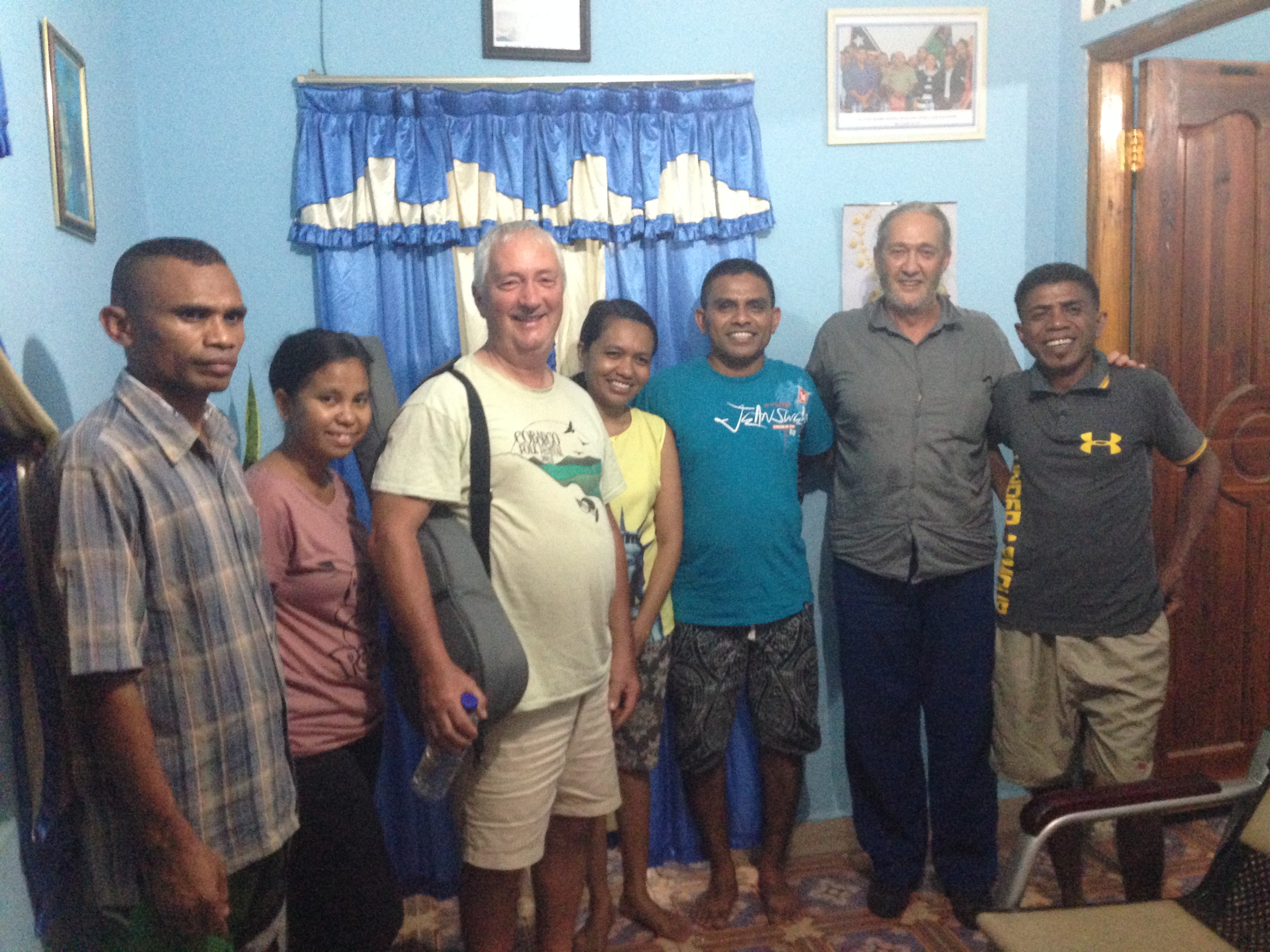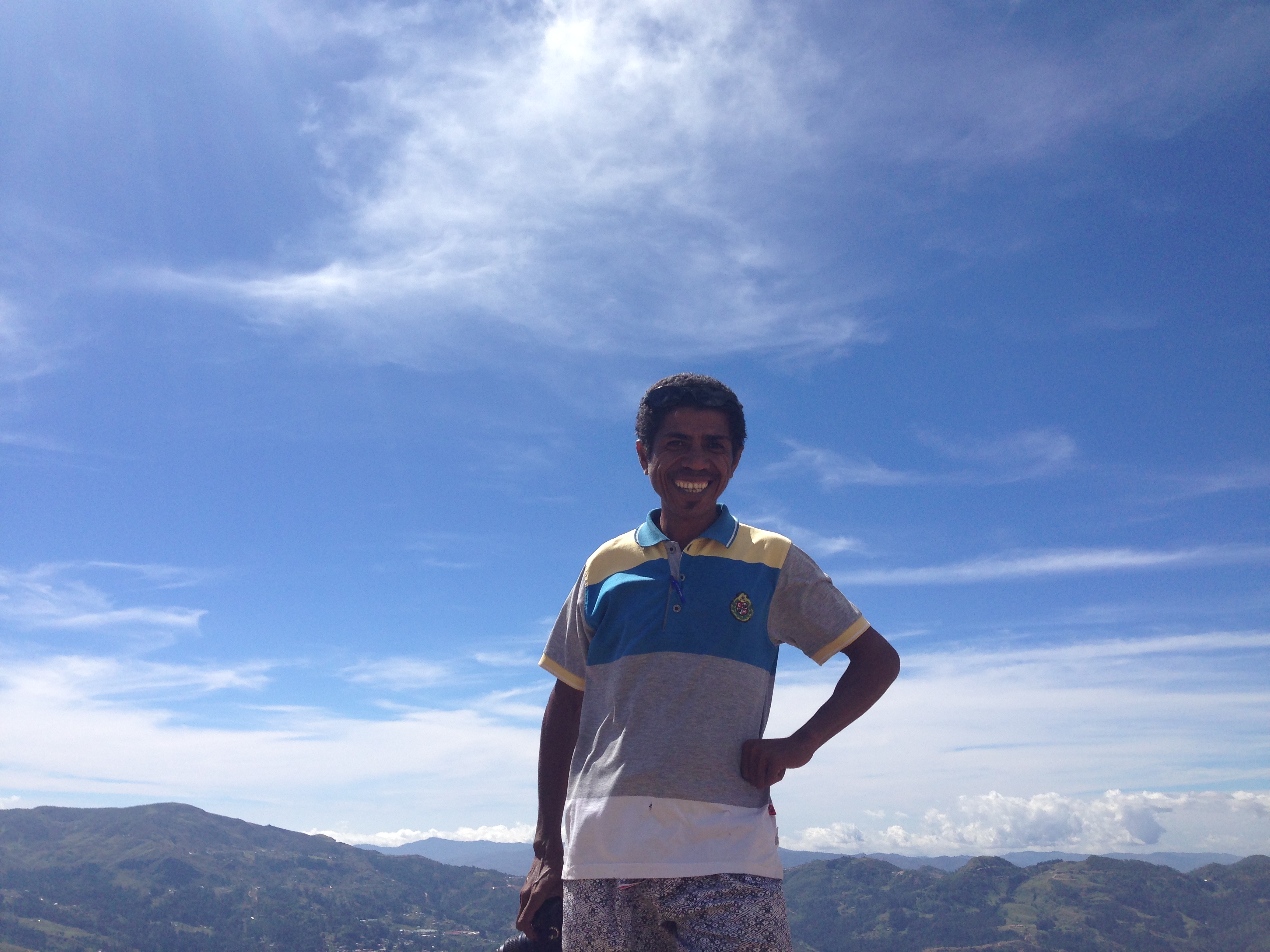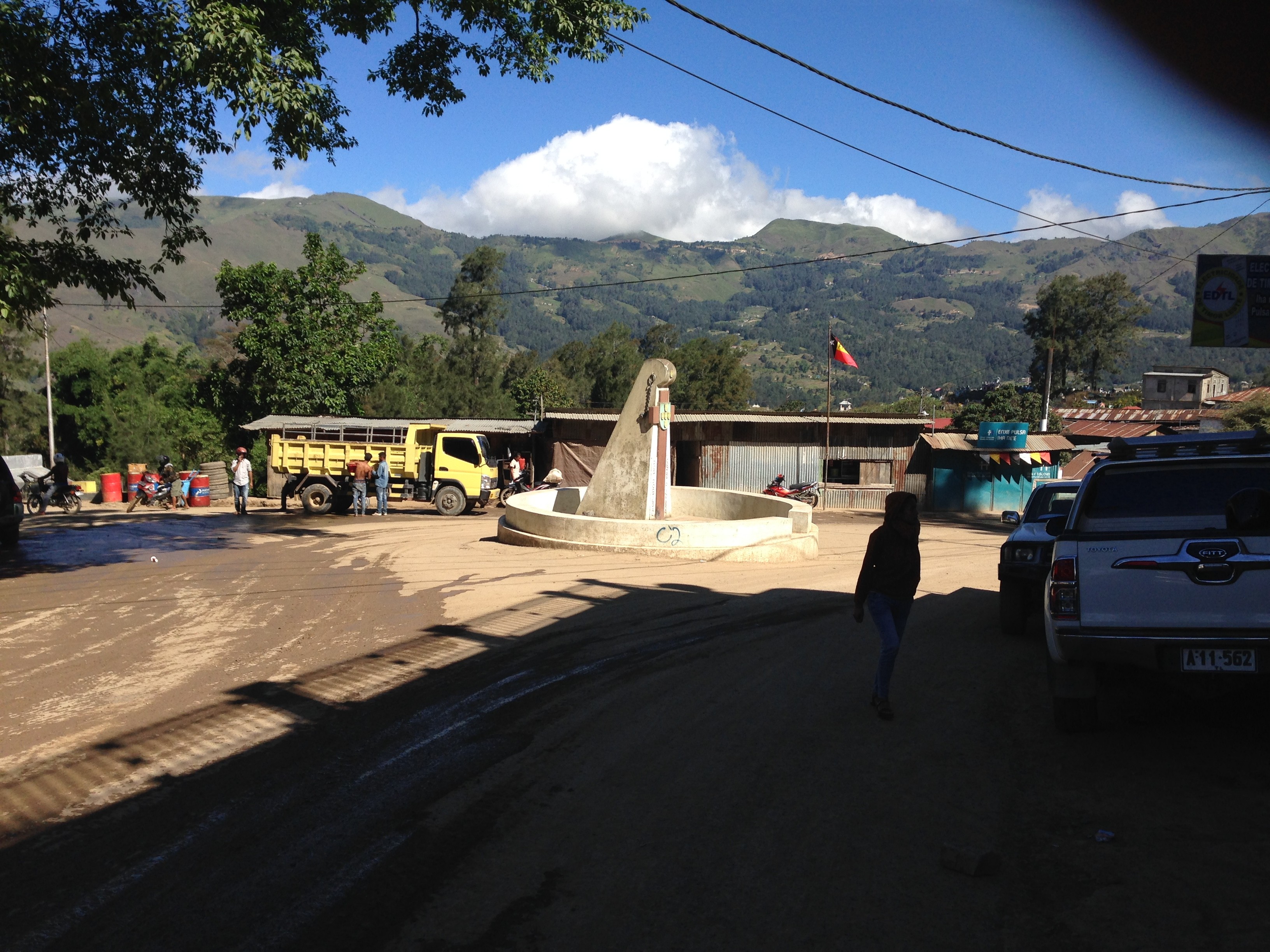After two days in Natarbora we’re once again on the road, and pass a sign that is a reminder of Timor Leste’s national symbol and why it’s unwise to swim in the ocean or the coastal streams and waterways.
Our troopcarrier is fully laden for the long journey, luggage for the four of us, Dave’s travelling guitar, three bags of the local specialty – Natarbora popping corn, and a surprise passenger that I don’t discover until we are halfway to Dili.
Along the way there are strange squeaking noises every time I adjust my position in the back of the carrier. Somewhere before Maubisse though, from behind the bags of corn emerged a chook destined for Natarbora.
Our return to Dili will take us along the coast to Betano, a significant site in Australian and Timor Leste shared history.
HMAS Voyager became grounded in the bay at Betano after offloading the 2/4th Independent Company on 25 September 1942.
The ship was blown up and scuttled after it could not be refloated. On December 1 1942, HMAS Armidale was sunk by 13 Japanese aircraft here while attempting to evacuate Australian and Dutch soldiers and deliver a relief contingent.
There is no memorial, no plaque, no monument, nothing that gives an inkling of the events that took place here in WW2, only the rusting remains of HMAS Voyager.
The ruins of a Portuguese Fort are a crumbling reminder of the occupations Timor Leste has endured, survived, and risen above.
It is only when we visit the memorial at Dare on Sunday, the day before we leave Timor that the impact of the events here at Betano hit home.
Check out the remarkable story of the evacuation of Sparrow Force at Betano.
As we leave Betano and the coast and head through the mountains to Dili via Same, Maubiisse, and Aileu, we pass one of the country’s three main electricity generation plants.
Large diesel generation power stations supply the electricity for Timor, just why diesel was chosen considering the potential for gas and hydro is hard to understand. The cost in economic terms alone is unsustainable.
From Betano to Dili the roads represent the best and worst you can imagine.
Between Maubisse and Aileu the recently sealed sections are as good as any in Australia, and the scenery is spectacular. There is no doubt this place will be seen as a mecca for motorcycle touring and cycling enthusiasts in years to come. For the latter though you will need to be very fit!
The tourist potential is yet to be realised, however, it could well secure the economic future well beyond any gas and oil income.
The challenge will be to see that “development” be in keeping with the environment and culture of the Timorese people, and have the ownership of local communities.
Late afternoon and we stop for coffee at Aileu, the renowned Maubisse coffee, and it is good. We are now 2-3 hours from Dili, taking a new section of road that will take us out of the mountains alongside the Comoro River.
Once completed, like much of the road network it will be fantastic, but not now.
We arrive in Dili a little after 6pm and spend the evening with Jose, his family and good friend Carlos.
Some welcome relaxation after hours on the road, with food song and wine. I had almost expected our “surprise passenger” to make an appearance as part of the evening meal, but our feathered friend was perhaps destined for a long and productive life in a backyard henhouse.
Carlos works on an oil platform in the Timor Sea and shares songs in Tetun and stories of life on the platform with us. He earns good money in Timorese terms and has taken on board Jose’s philosophy of sharing his good fortune in helping others.
After a night of merriment and reflection of our time in Natarbora it’s back to Fatuhada for some well-earned rest.
It’s Sunday, and Dave and I walk to Dili Harbour via the back lanes.
The streets have been swept, but the acrid smell from wood smoke cooking and the odour of the grey water that runs in open drains lingers.
Across the harbour the smoke haze blurs the horizon to the north, east and west along the coast.
An elderly man is sifting thru the piles of garbage carrying a bag of plastic detritus, a broken pushbike wheel his prize.
The main drag along the harbour here is lined with official buildings embassies, residences, and tourist accommodation, their grandeur stands in stark contrast to the homes and conditions in much of the Comoro district and the poorer suburbs of Dili.
Back at Fatuhada there’s been some concreting work underway to repair the carpark at the convent. A crew of about eight or so young fellas assisted by some of the trainee Sisters are spreading a thin layer over already broken concrete and rumble.
They had poured some narrow strips the day before to act as a level and rough formwork and were now filling in between.
It is hot, humid, tough, heavy work for the young Sisters carrying buckets of stones.
As an old concreter, I haven’t the heart to tell them that their all hard work is unlikely to be a success.
Lunch is another feast with the Sisters, chicken, steamed greens with chilli and spices, rice and noodles followed by those delicious little sweet bananas, mango, and pawpaw.
After lunch, Jose takes us to Dare where the Timorese-Australian memorial is sited overlooking Dili, the harbour and to the western headland which is dominated the statue of Cristo Rei – Christ the King.
Located on the original site of the 1969 memorial, the refurbished Fatunaba Memorial School was officially opened along with the Dare Museum and Cafe on Anzac Day 2009.
The view is spectacular, but we are not here for that. For me it is deeply emotional. The sacrifice and bravery of the Australian and Timorese during the invasion and occupation by the Japanese is palpable here.
Forty thousand Timorese lost their lives after the Australian troops were evacuated in 1942. Forty thousand killed by the Japanese troops as retribution for helping the Aussies.
Tears fall, I weep unashamedly.
Both anger and shame for our failure throughout the 25 years of the Indonesian invasion and occupation to return the care our countrymen were shown in WW2 and our more recent greed as a nation over oil and gas reserves in the Timor Sea.
We owe these people a great debt.
So it is with it is with a heavy heart that we wind our way back to Dili to visit the Santa Cruz cemetery and the grave of the resistance leader Sebastião Gomes. He was executed on October 28, 1991, by the Indonesians.
A memorial service details the circumstances, “On 28 October, Indonesian troops had located a group of resistance members in Dili’s Motael Church.
“A confrontation ensued between pro-integration activists and those in the church; when it was over, one man on each side was dead.
“Sebastião Gomes, a supporter of independence for East Timor, was taken out of the church and shot by Indonesian troops, and integration activist Afonso Henriques was stabbed and killed during the fight.
“Several thousand men, women, and children walked from the Motael Church to the nearby Santa Cruz cemetery.”
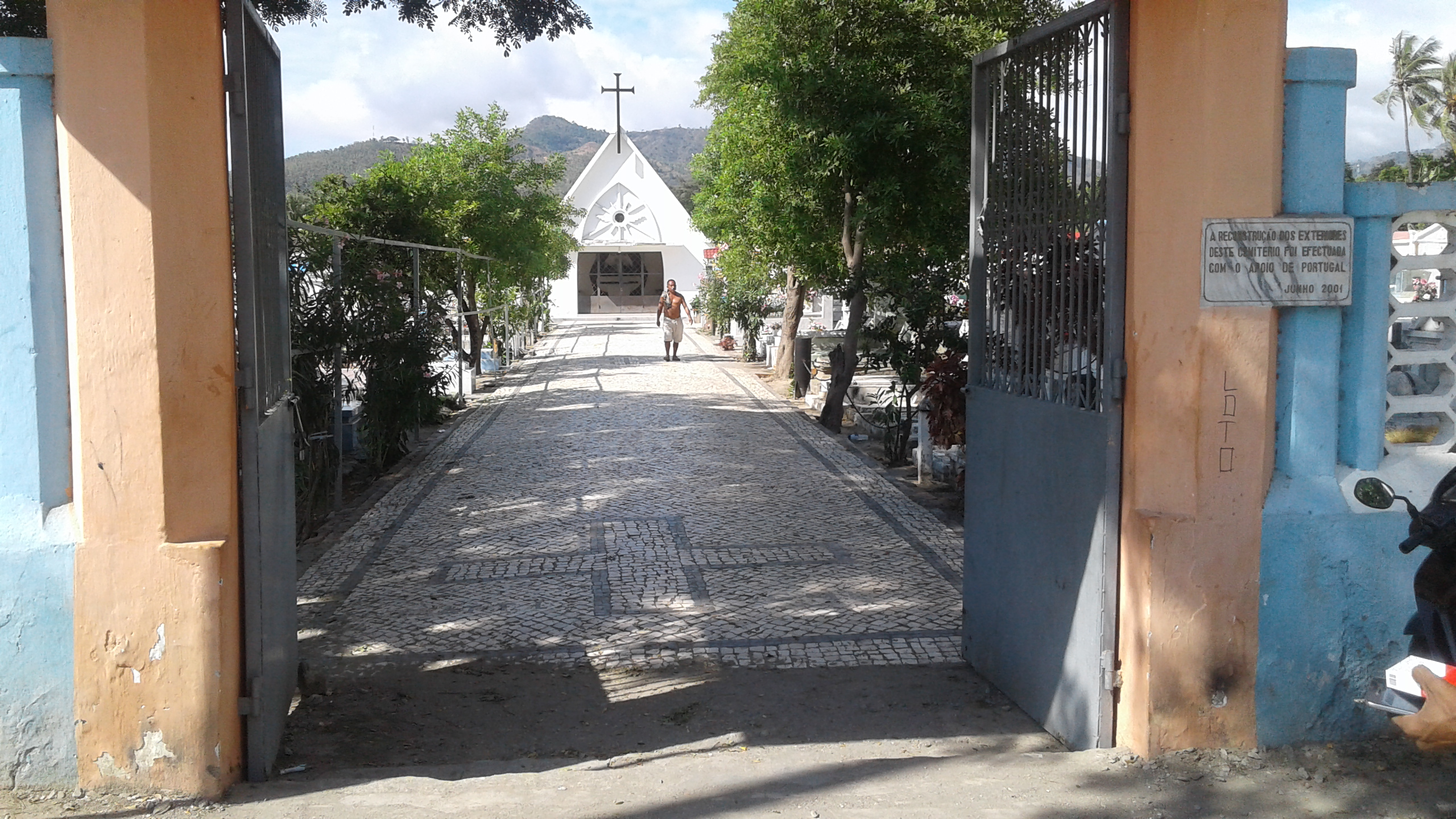
“At least 250 East Timorese pro-independence demonstrators were shot and killed by Indonesian troops at the Santa Cruz Cemetery.” Photo: Tim Holt
At least 250 East Timorese pro-independence demonstrators were shot and killed by Indonesian troops at the Santa Cruz Cemetery.
This was the Santa Cruz Massacre, it is also known as the Dili Massacre.
Our last night in Dili is here and we’ve been invited to spend the evening with Lorenzo and family at their home in the Comoro district. It is another wonderful gathering with of food, song and conversation.
We had met Lorenzo on our first afternoon in Dili and after the events of today, it was a delight to meet again.
After dinner, I had the opportunity for a long conversation with Anderius Tani.
Anderius grew up in the East Timorese enclave of Oecusse in West Timor, the eldest of five sisters and two brothers. His parents are subsistence farmers, surviving only on what corn, rice, and livestock they grow.
The only way to pay school fees for their large family was to sell livestock, beef, chicken or cows.
Growing up during the Indonesian occupation school was compulsory, and Anderius says they received a good education. He completed his senior secondary school during the UN transition. In 2001 Anderius had to leave his family and community in Oecusse and move to Dili to further his studies, and it was here that he and a number of other young students were supported by Jose.
Anderius and Jose had grown up in the same village and that friendship and support made all the difference while studying at the University of Timor Leste in Dili far from home.
The same is true for the many others Jose continues to support today.
Despite the challenges of those years, Anderius graduated in 2007 with a Diploma of Electrical Engineering, and in the years since then, he returned to study public policy and management. A scholarship saw him spend three years in New Zealand graduating with a Bachelor of Development Studies and International Relations in 2015.
In between work and study Anderius married and has a young family to support. Those years in New Zealand away from family were hard and lonely for him.
It is a remarkable achievement coming from such humble beginnings, Anderius talks of achieving what his family had hoped for. They are undoubtedly a very proud family.
After returning from NZ he worked for the UN on development programs but has since branched out into consultancy.
Currently, he is working on the Dili to Ainaro road project.
For Jose, the education Anderius and Lorenzo (studying engineering) have received is the key to his country’s future and they are all passionate about nurturing and supporting others to achieve the same goals.
Before our evening together ends the conversation turns to the challenges ahead from Timor Leste.
Timor is a patriarchal society and that can be confronting, when experiencing the depth of that tradition for the first time.
Anderius though is passionate that it must change. He says the older generation has to accept that young women need the same education and opportunity.
That change is underway with such a young and increasingly educated population. Many marry and have children at a very young age, however, restricting that potential.
Health, education, water, sanitation, unemployment – there are many, many issues.
Dave and I talk of our experiences on the roads, noting our concern that the road improvements underway might lead to rising speeds, coupled with the lack of seatbelts and the use of mobile phones that the country might see fatalities and spiraling injuries in road accidents.
Monday and our final breakfast with the Sisters at Fatuhada. Delphina has given us several kilos of coffee beans from her home district of Maubisse to deliver to friends she made in Tathra during her stay earlier in the year.
With our bags packed we load them for the last time into the Toyota and say farewell to the Sisters.
We still have quite a day ahead of us before catching the late afternoon flight to Darwin.
First is a visit to the Timorese Resistance Archive and Museum, but we are to be disappointed, it is not open today!
However, there is still much to do as we have a meeting with Ego Lemos at the Permatil Office to discuss the Permatil schools camp to be held towards the end of October 2018 in Maubisse, and arrangements for Ego’s visit to Australia for the Cobargo Folk Festival, now likely to be a tour of some several months taking in the Permaculture Convergence, and of course more discussion around the formation of the Timorese choir to visit here in 2020.
It is also a chance to tell Ego about our visit to the school gardens in Manatuto and Natarbora. Ego’s passion is to see agriculture across Timor Leste based on Permaculture, and that is no pipe dream. The traditional farming practices are already in tune with those principals and the landscape is certainly not readily suitable for broadacre agriculture.
A final meal on the waterfront with Jose and Augus, and an hour or two at Jose’s home before we drive to the airport.
Jose talks about education and for Jose education is number one. It is the key for such a young country. Yet there are difficulties that are hard to imagine in a country like Australia.
Language is one.
The textbooks and curriculum have been written in Portuguese, yet only 45% of the population speak Portuguese. Despite that it was declared the official language following independence.
So, the difficulty for teachers is trying to teach students in a language neither understands.
Tetun is the indigenous language that everyone speaks, though there are many dialects, Bahasa Indonesian is also widely spoken, and English is also in favour. Portuguese is not, certainly among the young and increasingly educated.
However, textbooks are being translated into Tetun, but it will take time for that to work its way through the education system.
Anderius says for his generation and those following Portuguese is dead.
Tetun, Bahasa and English are the languages of choice. So, this is a people that will be fluent in three languages, perhaps some lessons there for Australia!
Mid-afternoon and it’s hot and muggy, and it’s time to head to Dili Airport for the long flight home, a final journey through Comoro and a farewell to friends well made.
We check our baggage in, our paperwork is stamped for departure, we sit outside the airport with Jose and Augus for the last time.
If our plans fall into place Dave and I will return next year, for the moment I watch a group of young Timorese men resplendent in red shirts and caps emblazoned with the Timor Leste flag heading to Australia as part of a training program.
The Airnorth flight takes off just after five, heading south to Darwin over the island nation.
The skies are clear, unlike our arrival eight days ago, and the spectacular beauty of Timor Leste is revealed below framed by blue skies and a setting sun.
We land in Darwin around eight in the evening and meet an old acquaintance of Dave’s.
In 2014 Rob Wesley-Smith and his brothers received Timor Leste’s highest honour, The Order of Timor Leste, in recognition of their efforts to help the country after the Indonesian army invaded in 1975.
Rob was meeting another long-time aid worker returning from Timor Leste, Ros Dunlop.
Ros is one of Australia’s leading clarinettists/bass clarinettists, and along with Martin Wesley-Smith, one of Australia’s leading composers and long-time supporter of East Timor, both toured and performed in East Timor in 2002.
Ros Dunlop is the author of Lian Husi Klamar ~ Sounds of the Soul: The Traditional Music of Timor-Leste.
We shared a pleasant warm and balmy evening together on the now tourist wharf at Darwin Harbour, with memories of 1975 and the long struggle for Timor Leste since.
With a beer or two, the traditional Aussie fair of fish and chips (Barramundi), there’s another surprise for us when long-time Bega Valley identities and founders of Magpie Music, Tony and Marianne Haid spotted us. They were in Darwin on a road trip around the top end.
Back to the airport for the red eye flight (12.45 am) to Sydney arriving at Mascot around 6.30am.
After breakfast and coffee at around 8.30, we board the flight to Canberra. What a chilly welcome that was too our nation’s capital – grey suits, white shirts, worn out faces and laptops, chillier than the -3 degrees we were told it was.
Another three hours and we’re back home in the Bega Valley. Familiar faces and warm embraces and a very excitable black dog welcome.


